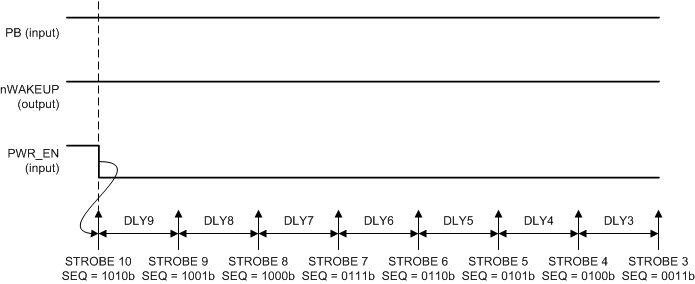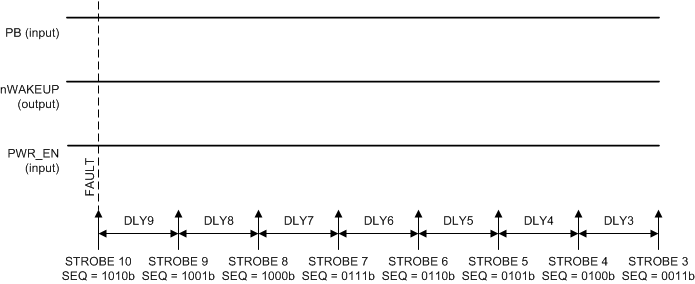ZHCSNM6A May 2021 – August 2021 TPS6521855
PRODUCTION DATA
- 1 特性
- 2 应用
- 3 说明
- 4 Revision History
- 5 Pin Configuration and Functions
- 6 Specifications
-
7 Detailed Description
- 7.1 Overview
- 7.2 Functional Block Diagram
- 7.3
Feature Description
- 7.3.1
Wake-Up and Power-Up and Power-Down Sequencing
- 7.3.1.1 Power-Up Sequencing
- 7.3.1.2 Power-Down Sequencing
- 7.3.1.3 Strobe 1 and Strobe 2
- 7.3.1.4 Supply Voltage Supervisor and Power-Good (PGOOD)
- 7.3.1.5 Internal LDO (INT_LDO)
- 7.3.1.6 Current Limited Load Switches
- 7.3.1.7 LDO1
- 7.3.1.8 UVLO
- 7.3.1.9 Power-Fail Comparator
- 7.3.1.10 DCDC3 and DCDC4 Power-Up Default Selection
- 7.3.1.11 I/O Configuration
- 7.3.1.12 Push Button Input (PB)
- 7.3.1.13 AC_DET Input (AC_DET)
- 7.3.1.14 Interrupt Pin (INT)
- 7.3.1.15 I2C Bus Operation
- 7.3.1
Wake-Up and Power-Up and Power-Down Sequencing
- 7.4 Device Functional Modes
- 7.5 Register Maps
- 8 Application and Implementation
- 9 Power Supply Recommendations
- 10Layout
- 11Device and Documentation Support
- 12Mechanical, Packaging, and Orderable Information
7.3.1.3 Strobe 1 and Strobe 2
STROBE 1 and STROBE 2 are dedicated to DCDC5 and DCDC6 which are always-on; powered up as soon as the device exits the OFF state, and ON in any other state. STROBE 1 and STROBE 2 options are available only for DCDC5 and DCDC6, not for any other rails.
STROBE 1 and STROBE 2 occur in every power-up sequence, regardless if the rail is already powered up. If the rail is not to be powered up, its respective strobe setting must be set to 0x00.
When a power-down sequence initiates, STROBE 1 and STROBE 2 occur only if the FSEAL bit is 0b. Otherwise, both strobes are omitted and DCDC5 and DCDC6 maintain state.
The power-down sequence follows the reverse of the power-up sequence. STROBE2 and STROBE1 are executed only if FSEAL bit is 0b.
 Figure 7-4 Power-Down Sequences to OFF State; PWR_EN is Power-Down Event; FSEAL = 0b
Figure 7-4 Power-Down Sequences to OFF State; PWR_EN is Power-Down Event; FSEAL = 0b
